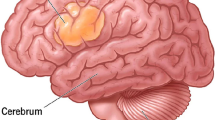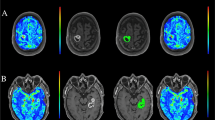Abstract
Objectives
Assessing a posterior fossa tumour in an adult can be challenging. Metastasis, haemangioblastoma, ependymal tumours, and medulloblastoma are the most common diagnostic possibilities. Our aim was to evaluate the contribution of magnetic resonance spectroscopy (MRS) in the diagnosis of these entities.
Methods
We retrospectively evaluated 56 consecutive patients with a posterior fossa tumour and histological diagnosis of ependymal tumour, medulloblastoma, haemangioblastoma, and metastasis in which good-quality spectra at short (TE 30 ms) or/and intermediate (TE, 136 ms) TE were available. Spectra were compared using the Mann-Whitney U non-parametric test in order to select the spectral datapoints and the intensity ratios that showed significant differences between groups of lesions. Performance of these datapoints and their ratios were assessed with ROC curves.
Results
The most characteristic signatures on spectroscopy were high choline (Cho) in medulloblastoma (p < 0.001), high myoinositol (mIns) in ependymal tumours (p < 0.05), and high lipids (LIP) in haemangioblastoma (p < 0.01) and metastasis (p < 0.01). Selected ratios between normalised intensity signals of resonances provided accuracy values between 79 and 95% for pairwise comparisons. Intensity ratio NI3.21ppm/3.55ppm provided satisfactory discrimination between medulloblastoma and ependymal tumours (accuracy, 92%), ratio NI2.11ppm/1.10ppm discriminated ependymal tumours from haemangioblastoma (accuracy, 94%), ratio NI3.21ppm/1.13ppm discriminated haemangioblastoma from medulloblastoma (accuracy, 95%), and ratio NI1.28ppm/2.02pmm discriminated haemangioblastoma from metastasis (accuracy, 83%).
Conclusions
MRS may improve the non-invasive diagnosis of posterior fossa tumours in adults.
Key Points
• High choline suggests a medulloblastoma in a posterior fossa tumour.
• High myoinositol suggests an ependymal lesion in a posterior fossa tumour.
• High lipids suggest a metastasis or a haemangioblastoma in a posterior fossa tumour.





Similar content being viewed by others
Abbreviations
- Cho:
-
Choline
- Glx:
-
Glutamine-glutamate
- LIP:
-
Lipids
- MRS:
-
Magnetic resonance spectroscopy
- mIns:
-
Myoinositol
- NI:
-
Normalised to unit length datapoint intensities
References
Ostrom QT, Gittleman H, Liao P et al (2014) CBTRUS statistical report: primary brain and central nervous system tumors diagnosed in the United States in 2007-2011. Neuro Oncol 16:iv1–iv63
Grossman R, Ram Z (2016) Posterior fossa intra-axial tumors in adults. World Neurosurgery 88:140–145
Eichler AF, Loeffler JS (2007) Multidisciplinary management of brain metastasis. Oncologist 12:884–898
North C, Segall HD, Stanley P, Zee CS, Ahmadi J, McComb JG (1985) Early detection on intracranial seeding from medulloblastoma. AJNR Am J Neuroradiol 6:11–13
Kanno H, Kobayashi N, Nakanowatari S (2014) Pathological and clinical features and management of central nervous system hemangioblastomas in von Hippel-Lindau disease. J Kidney Cancer VHL 1:46–55
Slater A, Moore NR, Huson SM (2003) The natural history of cerebellar hemangioblastomas in von Hippel-Lindau disease. AJNR Am J Neuroradiol 24:1570–1574
Dowling C, Bollen AW, Noworolski SM et al (2001) Preoperative proton MR spectroscopy imaging of brain tumors: correlation with histopathologic analysis of resection specimens. AJNR Am J Neuroradiol 22:604–612
Howe FA, Barton SJ, Cudlip SA et al (2003) Metabolic profiles of human brain tumors using quantitative in vivo 1H magnetic resonance spectroscopy. Magn Reson Med 49:223–232
Majós C, Julià-Sapé M, Alonso J et al (2004) Brain tumor classification by proton MR spectroscopy: comparison of diagnostic accuracy at short and long TE. AJNR Am J Neuroradiol 25:1696–1704
Harris LM, Davies N, Macpherson L et al (2007) The use of short TE 1H MRS for childhood cerebellar tumours prior to histopathological diagnosis. Pediatr Radiol 37:1101–1109
Vicente J, Fuster-Garcia E, Tortajada S et al (2013) Accurate classification of childhood brain tumours by in vivo 1H MRS- a multi-centre study. Eur J Cancer 49:658–667
Peet AC, Davies NP, Ridley L et al (2017) Magnetic resonance spectroscopy suggests key differences in the metastatic behavior of medulloblastoma. Eur J Cancer 43:1037–1044
Davies NP, Wilson M, Harris LM et al (2008) Identification and characterization of childhood cerebellar tumours by in vivo proton MRS. NMR Biomed 21:908–918
Scheneider JF, Confort-Gouny S, Viola A et al (2007) Multiparametric differentiation of posterior fossa tumors in children using diffusion-weighted imaging and short echo-time 1H-MR spectroscopy. J Magn Reson Imaging 26:1390–1398
Plaza MJ, Borja MJ, Altman N, Saigal G (2013) Conventional and advanced MRI features of pediatric intracranial tumors: posterior fossa and suprasellar tumors. AJR Am J Roentgenol 200:1115–1124
Panigrahy A, Krieger MD, Gonzalez-Gomez I et al (2006) Quantitative short echo time 1H-MR spectroscopy of untreated pediatric brain tumors: preoperative diagnosis and characterization. AJNR Am J Neuroradiol 27:560–572
Moreno-Torres A, Martínez-Pérez I, Baquero M et al (2004) Taurine detection by proton magnetic resonance spectroscopy in medulloblastoma: contribution to noninvasive differential diagnosis with cerebellar astrocytoma. Neurosurgery 55:824–829
Majós C, Alonso J, Aguilera C et al (2002) Adult primitive neuroectodermal tumor: proton MR spectroscopic findings with possible application for differential diagnosis. Radiology 225:556–566
Stefan D, Di Cesare F, Andrasescu A et al (2009) Quantification of magnetic resonance spectroscopy signals: the jMRUI software package. Meas Sci Technol 20:104–135
Tate AR, Underwood J, Acosta DM et al (2006) Development of a decision support system for diagnosis and grading of brain tumours using in vivo magnetic resonance single voxel spectra. NMR Biomed 19:411–434
Hochberg Y, Tamhane AC (1987) Multiple comparisons procedures. Wiley, New York
Lehman NL (2008) Central nervous system tumors with ependymal features: a broadened spectrum of primarily ependymal differentiation? J Neuropathol Exp Neurol 67:177–188
Ho VB, Smirniotopoulus JG, Murpphy FM, Rushing EJ (1992) Radiologic-pathologic correlation: haemangioblastoma. AJNR Am J Neuroradiol 13:1343–1352
Remke M, Hielscher T, Northcott PA et al (2011) Adult medulloblastoma comprises three major molecular variants. J Clin Oncol 29:2717–2723
Bourgouin PM, Tampieri D, Grahovac SZ, Léger C, Del Carpio R, Melançon D (1992) CT and MR findings in adults with cerebellar medulloblastoma: comparison with findings in children. AJR Am J Roentgenol 159:609–612
Armington WG, Osborn AG, Cubberley DA et al (1985) Supratentorial ependymoma: CT appearance. Radiology 157:367–372
Shih RY, Smirniotopoulus JG (2016) Posterior fossa tumors in adult patients. Neuroimaging Clin N Am 26:493–510
Miller BL, Chang L, Booth R et al (1996) In vivo 1H MRS choline: correlation with in vitro chemistry/histology. Life Sci 58:1929–1935
Verma A, Kumar I, Verma N, Aggarwal P, Ojha R (2016) Magnetic resonance spectroscopy-revisiting the biochemical and molecular milieu of brain tumors. BBA Clin 5:170–178
Hattingen E, Raab P, Franz K, Zanella FE, Lanfermann H, Ulrich P (2008) Myo-inositol: a marker of reactive astrogliosis in glial tumors? NMR Biomed 21:233–241
Candiota AP, Majós C, Julià-Sapé M et al (2011) Non-invasive grading of astrocytic tumours from the relative contents of myo-inositol and glycine measured in vivo MRS. JBR-BTR 94:319–329
Funding
This work was partially funded by the Ministerio de Economía y Competitividad (MINECO) grant MOLIMAGLIO (SAF2014-52332-R). It was also funded by Centro de Investigación Biomédica en Red – Bioingeniería, Biomateriales y Nanomedicina (CIBER-BBN, [http://www.ciber-bbn.es/en]), an initiative of the Instituto de Salud Carlos III (Spain) co-funded by EU Fondo Europeo de Desarrollo Regional (FEDER).
Author information
Authors and Affiliations
Corresponding author
Ethics declarations
Guarantor
The scientific guarantor of this publication is Carlos Majós MD, PhD.
Conflict of interest
The authors of this manuscript declare no relationships with any companies, whose products or services may be related to the subject matter of the article.
Statistics and biometry
One of the authors has significant statistical expertise.
Informed consent
Written informed consent was obtained from all subjects (patients) in this study.
Ethical approval
Institutional Review Board approval was obtained.
Study subjects or cohorts overlap
Some study subjects or cohorts have been previously reported in:
a. Majós C, Alonso J, Aguilera C, et al (2003) Proton magnetic resonance spectroscopy (1H MRS) of human brain tumours: assessment of differences between tumour types and its applicability in brain tumour categorization. Eur Radio 13:582–91.
b. Mora P, Majós C, Castañer S, et al (2014) 1H-MRS is useful to reinforce the suspicion of primary central nervous system lymphoma prior to surgery. Eur Radiol 24:2895–905.
c. Majós C, Alonso J, Aguilera C, Serrallonga M, Acebes JJ, Arús C, Gili J. Adult primitive neuroectodermal tumour: Proton MR Spectroscopic findings with possible application for differential diagnosis. Radiology 2002;225:556–566.
d. Majós C, Julià-Sapé M, Alonso J, Serrallonga M, Aguilera C, Acebes JJ, Arús C, Gili J. Brain tumor classification by proton MR spectroscopy: comparison of diagnostic accuracy at short and long TE. AJNR Am J Neuroradiol 2004;25:1696–1704.
e. Majós C, Aguilera C, Cos M, Camins A, Candiota AP, Delgado-Goñi T, Samitier A, Castañer S, Sánchez JJ, Mato D, Acebes JJ, Arús C. In vivo proton magnetic resonance spectroscopy of intraventricular tumours of the Brain. Eur Radiol 2009;19:2049–2059.
Methodology
• retrospective
• diagnostic or prognostic study/observational
• performed at one institution
Rights and permissions
About this article
Cite this article
Mora, P., Pons, A., Cos, M. et al. Magnetic resonance spectroscopy in posterior fossa tumours: the tumour spectroscopic signature may improve discrimination in adults among haemangioblastoma, ependymal tumours, medulloblastoma, and metastasis. Eur Radiol 29, 2792–2801 (2019). https://doi.org/10.1007/s00330-018-5879-z
Received:
Revised:
Accepted:
Published:
Issue Date:
DOI: https://doi.org/10.1007/s00330-018-5879-z




